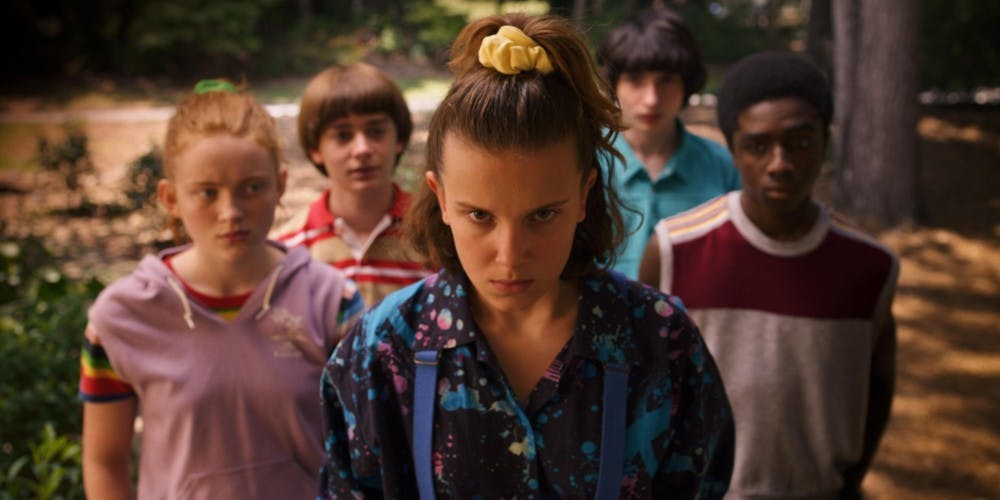When “Stranger Things,” the retro-styled brainchild of brothers Matt and Ross Duffer, hit living room televisions everywhere in the summer of 2016, a good deal of its allure was that it felt totally singular despite the slew of 80s classics that inspired it.
In the age of increasingly familiar serious primetime dramas, and in the midst of an otherwise forgettable catalog of Netflix Originals, the brothers’ stylish sci-fi romp through the woods of Hawkins, Indiana, was an instant must-binge.
Even through a divisive sophomore season, it remained clear there was legitimate care put into “Stranger Things” despite the surging tide of utterly derivative dreck that fleshed out the rest of the Netflix Original canon, viewers could count on the series’ creators to spin a compelling yarn full of heart.
Now, two seasons and a popularity skyrocket later, “Stranger Things” has sunk into the muck. Though their aspirations are loftier and the stakes are higher than ever, the Duffers prove with “Stranger Things 3” that maybe what was initially conceived as a one-off ought to have stayed that way.
And if the series is meant to continue on its planned trajectory — and with record-setting streaming numbers for Netflix, it undoubtedly will — it’s well past time for them to consider what made it worth a watch in the first place.
At its outset, “Stranger Things 3” makes a pretty compelling justification for its own existence. Since the fiery thrills of the prior season’s finale, Russian scientists have stumbled across the interdimensional rift that simply won’t leave its poor Midwest town alone, and they’ve set out to do what any fictional mad scientist would do and rip it wide open again.
It’s a simple enough conceit for the show, and it works at first because it bypasses the familiarity of recycling the same government antagonists of earlier seasons.
It also quickly becomes numbingly derivative. Antics ensue, unexpectedly perfect friendships form and once again the growing cast of charming children worm their way into the heart of a high-stakes mystery.
If you’ve seen seasons one and two, you know just how this one will pan out, for better or for worse: with loads of quips, lots of interdimensional antics and a healthy dose of Winona Ryder playing detective for good measure.
As the Duffers continue to unravel this multi-season narrative yarn, it’s increasingly clear that they’ve stretched a good idea well beyond its welcome. Is this popular because it’s vital, or is it simply vital purely because it’s popular?
If “Stranger Things” was a revelation because it rooted the mysteries of its interdimensional freakshow in the experiences of its adorable young protagonists, and “Stranger Things 2” was a worthy successor because it considered the lingering implications of those mysteries on its characters and world, then “Stranger Things 3” is a middling failure because it proves the series doesn’t know where to steer itself beyond that.
As the characters continue to grow, the series they inhabit refuses to, recycling the same cyclical plot structures time and time again and throwing only slightly amended iterations of the same big bads at them each season. Last season, it was mad scientists and a big monster from another dimension. This time, it’s Russian mad scientists and another big monster from another dimension.
It’s then perhaps a testament to those very characters that “Stranger Things 3” isn’t a dud through and through. The core players remain as likable as ever, despite the less-than-compelling material they’ve been given. But it’s new characters and old supporting players stepping to the forefront who prove to be MVPs this time around.
Many of the series’ greatest joys have always been in the camaraderie of its leads, and with new recruits like Maya Hawke — who delivers a powerhouse performance on a bathroom floor in one of the season’s later chapters — and familiar faces alike, it continues its legacy of giving its own audience serious FOMO over not being a part of their gang.
Amidst a jumble of plot threads, the brothers’ pairing of Hawke’s new character, Robin, with old favorites Steve and Dustin remains a high point of the season. It arguably even becomes their show for much of the time, as other characters such as Mike, Eleven and Will are given aimless adolescent antics to occupy their time while other characters crack the mysteries at hand.
But despite the continuing success of the series’ cast in providing the show its emotional backbone, the whole ordeal just can’t help but feel aimless this time around. After the divisiveness of “Stranger Things 2,” which doubled down on character growth and spun pure gold out of the first season’s most compelling unanswered questions at the expense of another fun small-town romp, it’s easy to see why the Duffers felt the need to correct their course.
But the problem is that they’ve course-corrected too far and in all the wrong ways. Jettisoning important plot lines might make sense for maximizing entertainment value, but in a show where ongoing mystery is the name of the game, it’s hardly the sensible choice.
And in their stead, the Duffers have concocted something stupefyingly familiar that plays more as a greatest hits album of “Stranger Things” iconography than a continuation of the story so many know and love. “Stranger Things 3” registers as little more than a cover song of the series’ own best moments and a less than memorable one at that.




